Apps
Auto Added by WPeMatico
Auto Added by WPeMatico
Coinbase’s mobile wallet app Coinbase Wallet puts you in control of your crypto assets. The app already lets you access decentralized crypto apps (dapps) using a dapp browser. But Coinbase is going one step further, with deep integrations with some of the most popular DeFi projects.
DeFi means “decentralized finance,” and it has been a hot trend in the cryptocurrency space. DeFi projects try to reproduce traditional financial products in the blockchain. For instance, you can lend and borrow money, invest in derivative assets and more.
A popular category of DeFi projects has been lending protocols, such as Compound and dYdX. Those protocols work pretty muck like LendingClub, but on the blockchain. Some users send money to a DeFi lending project to contribute to liquidity pools. Other users borrow money from that pool. Interest rates go up and down depending on supply and demand.
With today’s update, you can contribute to lending protocols much more easily. Coinbase Wallet lets you pick a cryptocurrency, compare interest rates across multiple DeFi protocols, interact with those protocols and view your balances in a unified dashboard, you don’t have to use Coinbase Wallet’s dapp browser.
Interest rates will change over time. At any time, you can check the current interest rate, see how much you’ve earned already and withdraw your crypto assets.
Those protocols rely on collateralized borrowing in order to avoid default payments. It means that borrowers have to lock crypto assets as collateral. You often have to provide a bigger collateral than what you’re trying to borrow with those DeFi protocols — that’s the downside of not relying on credit history and external financial data.
Again, this isn’t a traditional finance product. Your deposits are not insured and there could be some bugs in DeFi protocols. For instance, bZx recently suffered from a “flash loan” attack. But it’s an interesting crypto use case.
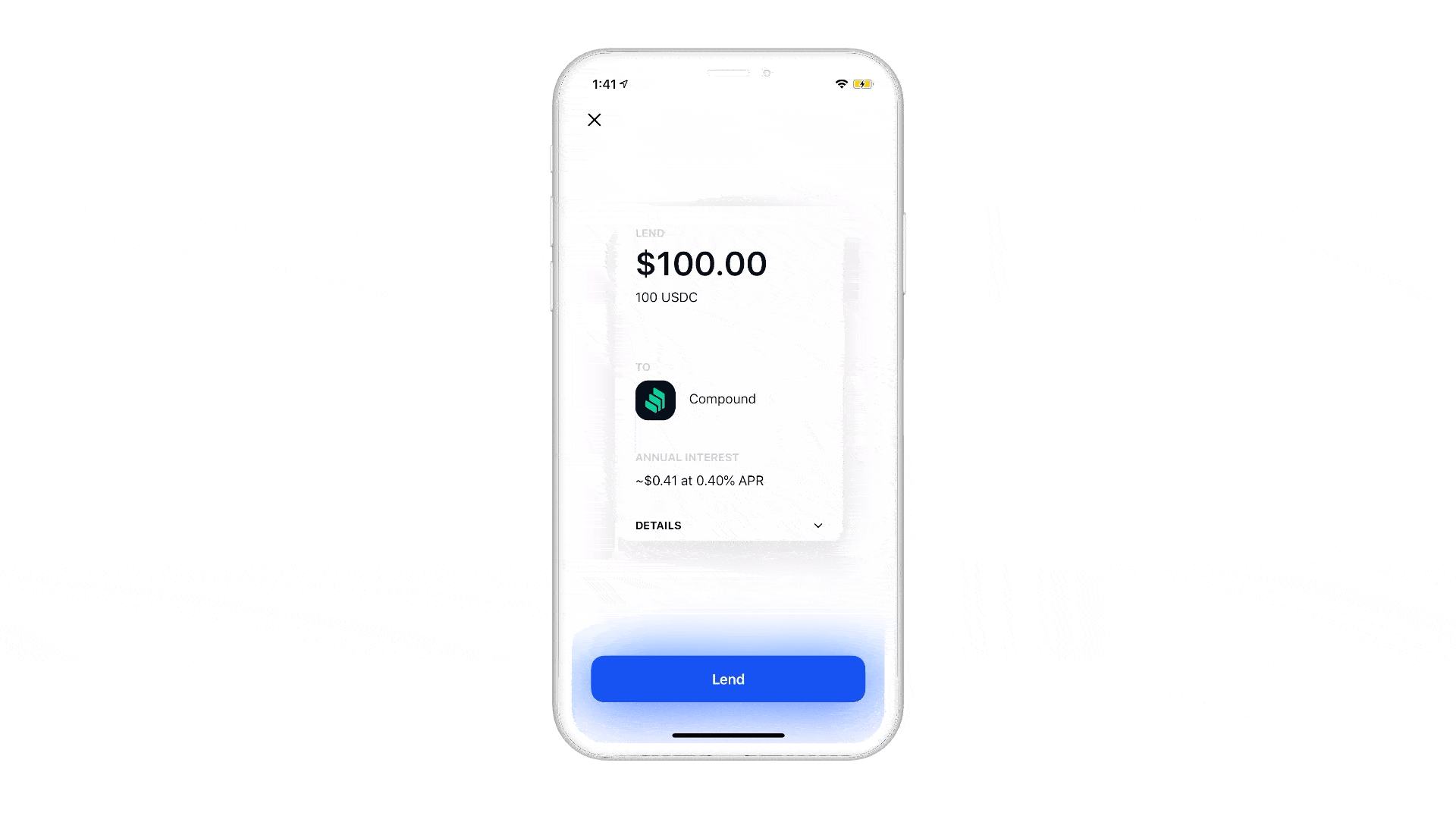
Powered by WPeMatico
OfferUp, a top online and mobile marketplace app, announced this morning it’s raising $120 million in a new round of funding led by competing marketplace letgo’s majority investor, OLX Group, and others. As a part of the deal, OfferUp will also be acquiring letgo’s classified business, with OLX Group gaining a 40% stake in the newly combined entity.
Other investors in the new round include existing OfferUp backers Andreessen Horowitz and Warburg Pincus. The funds will be put toward continued growth, product innovation and monetization efforts, OfferUp says.
The round will close with the closing of the acquisition, which is expected to take place sometime in May. To date, OfferUp has raised $380 million.
The acquisition will see two of the largest third-party buying and selling marketplaces — outside of Craigslist, eBay and Facebook Marketplace, of course — become a more significant threat to the incumbents. Together, the new entity will have more than 20 million monthly active users across the U.S. For consumers, the deal means they’ll no longer have to list in as many apps when looking to unload some household items, electronics, furniture or whatever else they want to sell.
“My vision for OfferUp has always been to build a company that helps people connect and prosper,” said Nick Huzar, OfferUp CEO, in a statement about the acquisition. “We’re combining the complementary strengths of OfferUp and letgo in order to deliver an even better buying and selling experience for our communities. OLX Group has unparalleled expertise and clear success with growing online marketplace businesses, so they’ll be a great partner as we continue to build the widest, simplest, and most trustworthy experience for our customers.”
OfferUp also acknowledged that mid-pandemic is an odd time to announce such a deal — especially at a time when the COVID-19 outbreak is affecting its own employees, its partners, and the buying and selling community itself. And this will continue for some time.
However, Huzar positions the deal as one that will allow the business to grow, despite the current state of affairs.
“This news helps us to continue to innovate and grow, in spite of these challenging times, and continue to deliver on that promise,” Huzar noted, in a company blog post.
For now, the OfferUp and letgo apps will remain separate experiences and no disruptions to any sales will be made. Consumers will also be able to download both apps to iOS and Android devices for the time being, too.
But soon, both sets of users will gain access to a larger network of buyers and sellers, along with nationwide shipping options, and trust and safety problems. We understand this will involve allowing users of both sets of apps to see more posts and interact with more buyers and sellers — so some sort of merging of the two networks is at play here. There will be additional changes to improve the user experience for all users in the future, as well, but the company isn’t sharing details on that today.
Letgo is bringing to the table an app with more than 100 million worldwide downloads, so there is a potential to reactivate some of the lapsed users who aren’t currently shopping or selling on its marketplace today. The two apps were often neck-and-neck in terms of their app store category rankings, though on iPhone OfferUp has maintained a slight lead. (See App Store and Google Play charts below.)


However, letgo’s business outside of North America will be separately owned and operated as part of the OLX Group, the companies said.
“Letgo and OfferUp have always shared the same core vision for how large America’s secondhand economy can become — harnessing tech innovation to bring about an extraordinarily positive impact on consumers’ wallets and also on the environment,” said letgo co-founder Alec Oxenford. “Bringing our apps together moves us much closer to that vision,” he added.
Prior to this deal, OfferUp had seen a number of executive departures, including the exit of Engineering lead and VP Peter Wilson in 2017, VP of Product Chloe Harford in 2018, VP of Employee Experience Deb Nielsen in 2018, subsequent VP of Employee Experience Sarah Bilton in 2019, and Chief Experience Officer Jerry Howe in January 2020. CFO Rodrigo Brumana has also left, which was previously unreported. The company’s interim CFO is Chief Growth Officer Ian Fliflet, and OfferUp is actively hiring for a new CFO, we’re told.
Huzar characterizes these changes as part of the challenges with growing a startup and getting the right people into place.
“As the company grows up, so must leaders and so must the culture. I think a lot of times when you’re scaling businesses…you go through evolutions where leaders really need to evolve and change,” he says. “If you look to Bill Carr, for example, our COO, you know he helped build out Amazon Video from nothing to over 2,000 employees. We had nobody in the halls of OfferUp that had seen that scale before,” Huzar added.
There’s some admiration for Amazon’s culture, as well.
“There are clearly things that Amazon has done very well — like their ability to innovate at scale is unbelievable,” Huzar says. “We do think people [who] come out of Amazon have great startup DNA. They’re very scrappy. They dive deep into the business and understand things. They can think big. There’s a lot of value I think from that business that I really appreciate,” he added.
OfferUp also just hired former ChannelAdvisor VP Mark Vandegrift as head of e-commerce this month, as the company focuses on growth and scale.
But not all employees have been on board with these exec shakeups. More than a handful of employee reviews on Glassdoor and chatter on networking app Blind speak to various company culture issues, women being treated inequitably, negative office politics, and attrition — including among senior management.
In addition to the COVID-19 crisis, OfferUp may have needed to merge to scale and compete with the marketplace giants. User growth was slowing, for instance — the userbase was 42 million annual users in 2018 that only grew to 44 million in 2019. Presumably, slower revenue growth had followed. (Huzar declined to speak to current revenue and valuation.)
A combination of OfferUp and letgo could help to strengthen numbers outside of coastal cities, like Seattle, L.A., and Miami, where OfferUp was historically strong. Letgo was stronger in other parts of the country, like the Midwest, Huzar says. OfferUp will also bring its shipping business to letgo, which could be particularly helpful now as people are looking to sell household items for extra cash.
The deal is still subject to regulatory approval. If given, the combined businesses will be operated by OfferUp, headquartered in Bellevue, Wash. Huzar will continue to be CEO of OfferUp and chairman of the board. Oxenford, meanwhile, will join the board and serve as a senior advisor to OLX Group and Prosus.
Because the deal is still in the process of closing, the companies can’t speak to any team changes, including potential layoffs as a result of overlapping positions or other redundancies, we’re told.
Updated 3/25/20, 4:00 PM ET with additional quotes and background, following Huzar interview.
Powered by WPeMatico
A new app called CatchUp might be useful for anyone who’s struggling to keep up with the latest headlines, podcasts and Netflix shows.
CatchUp is the latest offering from Mammoth Media, the startup behind chat fiction app Yarn and social polling app Wishbone. Founder and CEO Benoit Vatere told me that the product started out as a book summary app called Booknotes, but early users kept asking, “Why don’t you summarize more than books?”
So that’s exactly what CatchUp does, recapping the latest news and entertainment topics. The summaries should feel pretty familiar to anyone who’s watched videos on mobile social app — they’re vertically-oriented, broken up into slides, accompanied by text captions and last for just a few minutes.
Vatere told me that the topics are chosen based on what’s trending, either in Mammoth’s apps or more broadly in social media.
For example, when I opened CatchUp this morning, I watched a video laying out the basic info around the big topic one everyone’s mind: the coronavirus pandemic. Then I moved onto something lighter, a video breaking down the different streaming services available now.
It sounds like the CatchUp team is moving quickly. Vatere said they should be responsive to trends, creating new videos in just a day or two. At the same time, he said the app should offer a mix of news-y videos that will eventually disappear (“too much content kills retention in the app”) alongside more evergreen content.

Image Credits: Mammoth Media
He emphasized that this is very much an initial version of the app, and that the CatchUp team plans to iterate based on what users respond to. It’s English-only for now but could eventually add other languages. The company’s plans also include introducing monetization later on, starting with advertising and then eventually adding in-app purchases and subscriptions.
Vatere also suggested that while a CatchUp summary should stand on its own, it could also encourage deeper engagement.
“If you’re thinking, everybody is talking about ‘Love is Blind,’ what is this … you can listen for two minutes and understand the dynamic, understand what’s happening,” he said. “Then if it sounds really interesting to you, you can watch it. But if not, now you understand what’s being said.”
Powered by WPeMatico
It’s like Google Docs for everything. Screen is a free interactive multiplayer screensharing app that gives everyone a cursor so they can navigate, draw on and even code within the apps of their co-workers while voice or video chatting. Screen makes it easy and fun to co-design content, pair program, code review or debug together, or get feedback from a teacher.
Jahanzeb Sherwani sold his last screensharing tool Screenhero to Slack, but it never performed as well crammed inside the messaging app. Five years later, he’s accelerated the launch of Screen to today and made it free to help all the teams stuck working from home amidst coronavirus shelter-in-place orders.
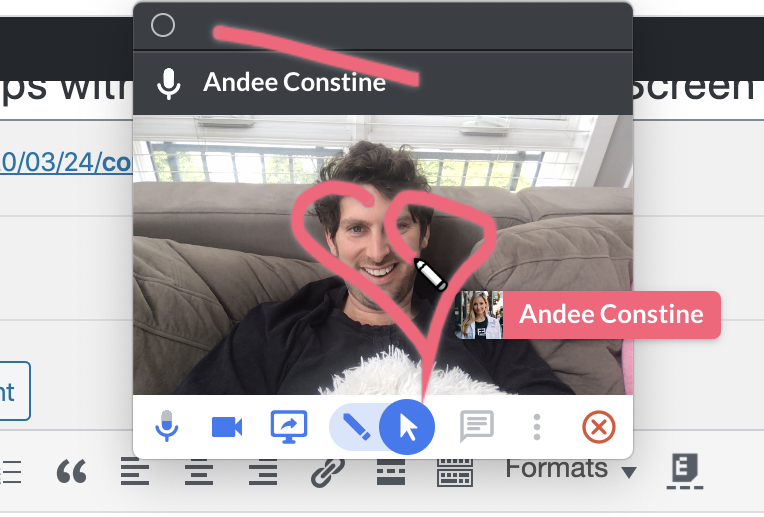
Sherwani claims that Screen is “2x-5x faster than other screen sharing tools, and has between 30ms-50ms end-to-end latency. Most other screen sharing tools have between 100ms-150ms.” For being built by just a two-person team, Screen has a remarkable breadth of features that are all responsive and intuitive. Sherwani says the startup is making due with “no funding, 100% bootstrapped, and I’d like to keep it that way” so he can control his destiny rather than being prodded for an exit by investors.
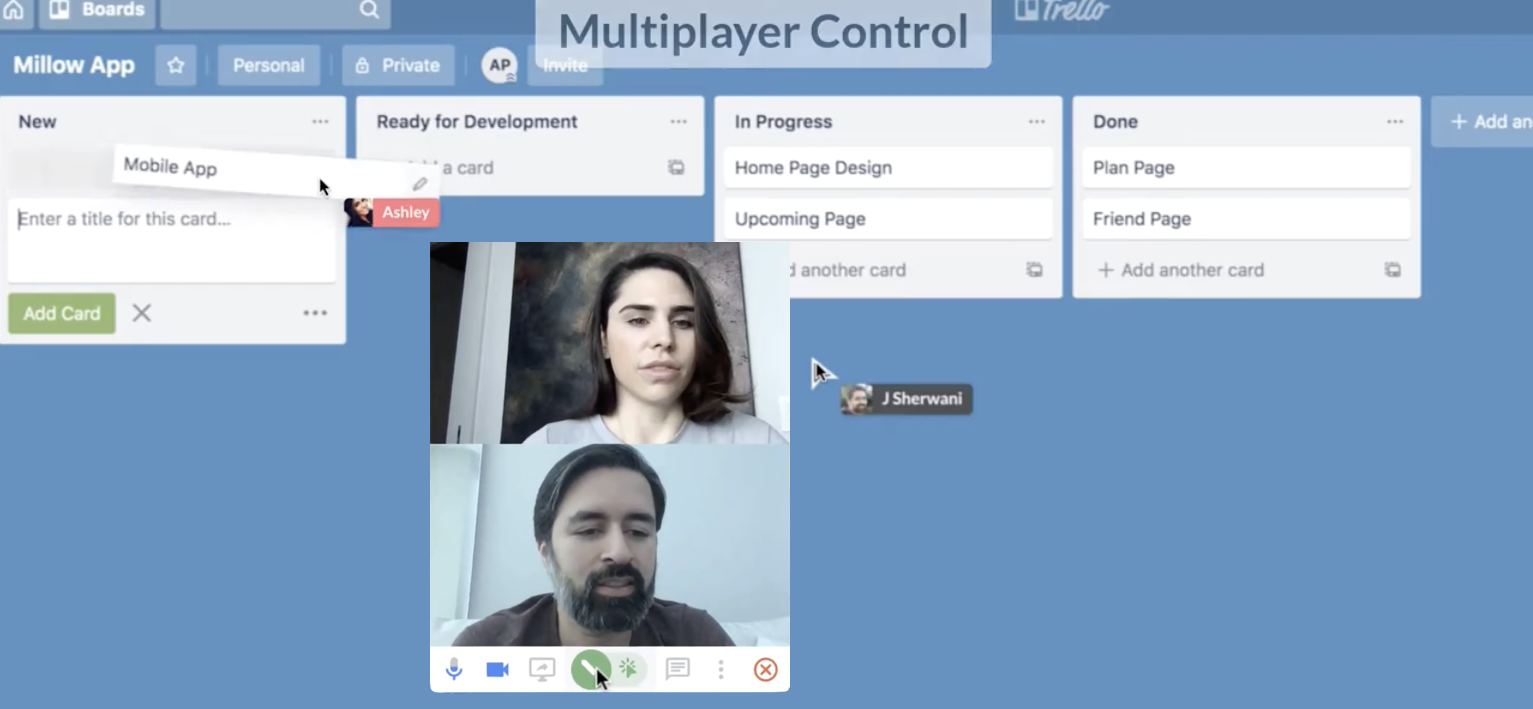
A few things you can do with Screen:
Normally Screen is free for joining meetings, $10 per month to host them and $20 per person per month for enterprise teams. But Sherwani writes that for now it’s free to host too “so you can stay healthy & productive during the coronavirus outbreak.” If you can afford to pay, you should, though, as “We’re trying this as an experiment in the hope that the number of paid users is sufficient to pay for our running costs to help us stay break-even.”
Sherwani’s new creation could become an acquisition target for video call giants like Zoom, but he might not be so willing to sell this time around. Founded in 2013, Screenhero was incredibly powerful for its time, offering some of the collaboration tools now in Screen. But after it was acquired by Slack after raising just $1.8 million, Screenhero never got the integration it deserved.
“We finally shipped interactive screen sharing almost three years later, but it wasn’t as performant as Screenhero, and was eventually removed in 2019,” Sherwani writes. “Given that it was used by a tiny fraction of Slack’s user-base, and had a high maintenance cost, this was the correct decision for Slack .” Still, he explains why a company like Screen is better off independent. “Embedding one complex piece of software in another imposes a lot more constraints, which makes it more expensive to build. It’s far easier to have a standalone app that just does one thing well.”
Screen actually does a lot of things well. I tried it with my wife, and the low latency and extensive flexibility made it downright delightful to try co-writing this article. It’s easy to imagine all sorts of social use cases springing up if teens get hold of Screen. The whole concept of screensharing is getting popularized by apps like Squad and Instagram’s new Co-Watching feature that launched today.
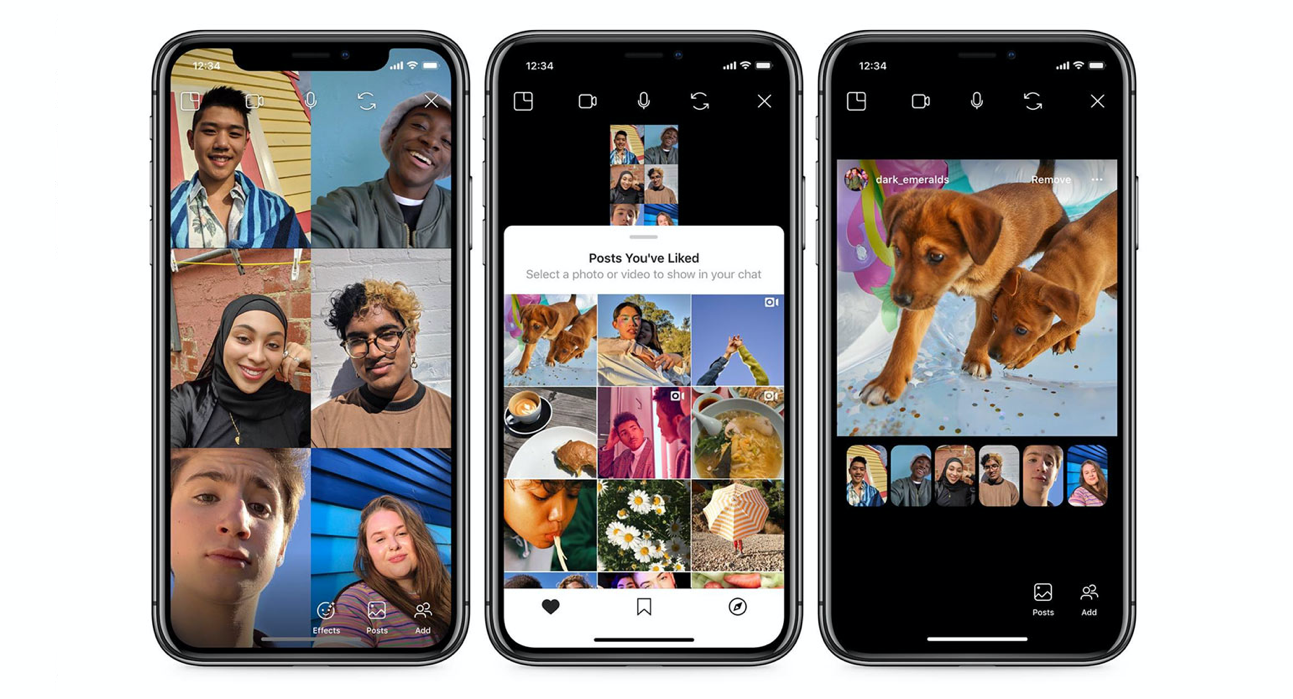
The new Co-Watching feature is like screensharing just for Instagram
Eventually, Screen wants to launch a virtual office feature so you can just instantly pull co-workers into meetings. That could make it feel a lot more like collaborating in the same room with someone, where you can start a conversation at any time. Screen could also democratize the remote work landscape by shifting meetings from top-down broadcasts by managers to jam sessions where everyone has a say.
Sherwani concludes, “When working together, everyone needs to have a seat at the table.”
Powered by WPeMatico
Apple has released software updates for the iPhone, the iPad, the Apple Watch, the Apple TV and the Mac. The biggest changes are on the iPad. Starting today, you can pair a mouse or trackpad with your iPad and use it to move a cursor on the display.
Apple unveiled trackpad support for iPadOS when it announced the new iPad Pro last week. While the company plans to sell a new Magic Keyboard with a built-in trackpad, you don’t need to buy a new iPad or accessory to access the feature.
When you pair a trackpad and start using it, Apple displays a rounded cursor on the screen. The cursor changes depending on what you’re hovering over. The cursor disappears and highlights the button you’re about to activate. It looks a bit like moving from one icon to another on the Apple TV.
If you’re moving a text cursor for instance, it becomes a vertical bar. If you’re resizing a text zone in a Pages document, it becomes two arrows. If you’re using a trackpad, iPadOS supports gestures that let you switch between apps, open the app switcher and activate the Dock or Control Center.
In addition to trackpad support, iOS and iPadOS 13.4 add a handful of features. You can share an iCloud Drive folder with another iCloud user — it works pretty much like a shared Dropbox folder.
There are nine new Memoji stickers, such as smiling face with hearts, hands pressed together and party face. Apple has tweaked buttons to archive/delete, move, reply and compose and email in the Mail app.
Additionally, Apple added the ability to release a single app binary on all App Stores, including the iOS and Mac App Store. It means that developers can release a paid app on the Mac and the iPhone — and you only have to buy it once.
Also, macOS 10.15.4 adds Screen Time Communication Limits, a feature that already exists on iOS. It lets you set limits on Messages and FaceTime calls.
When it comes to watchOS, version 6.2 adds ECG support for users in Chile, New Zealand and Turkey. Apple now lets developers provide in-app purchases for Apple Watch apps, as well.
All updates include bug fixes and security patches. Head over to the Settings app on your devices to download and update your devices if you haven’t enabled automatic software updates.
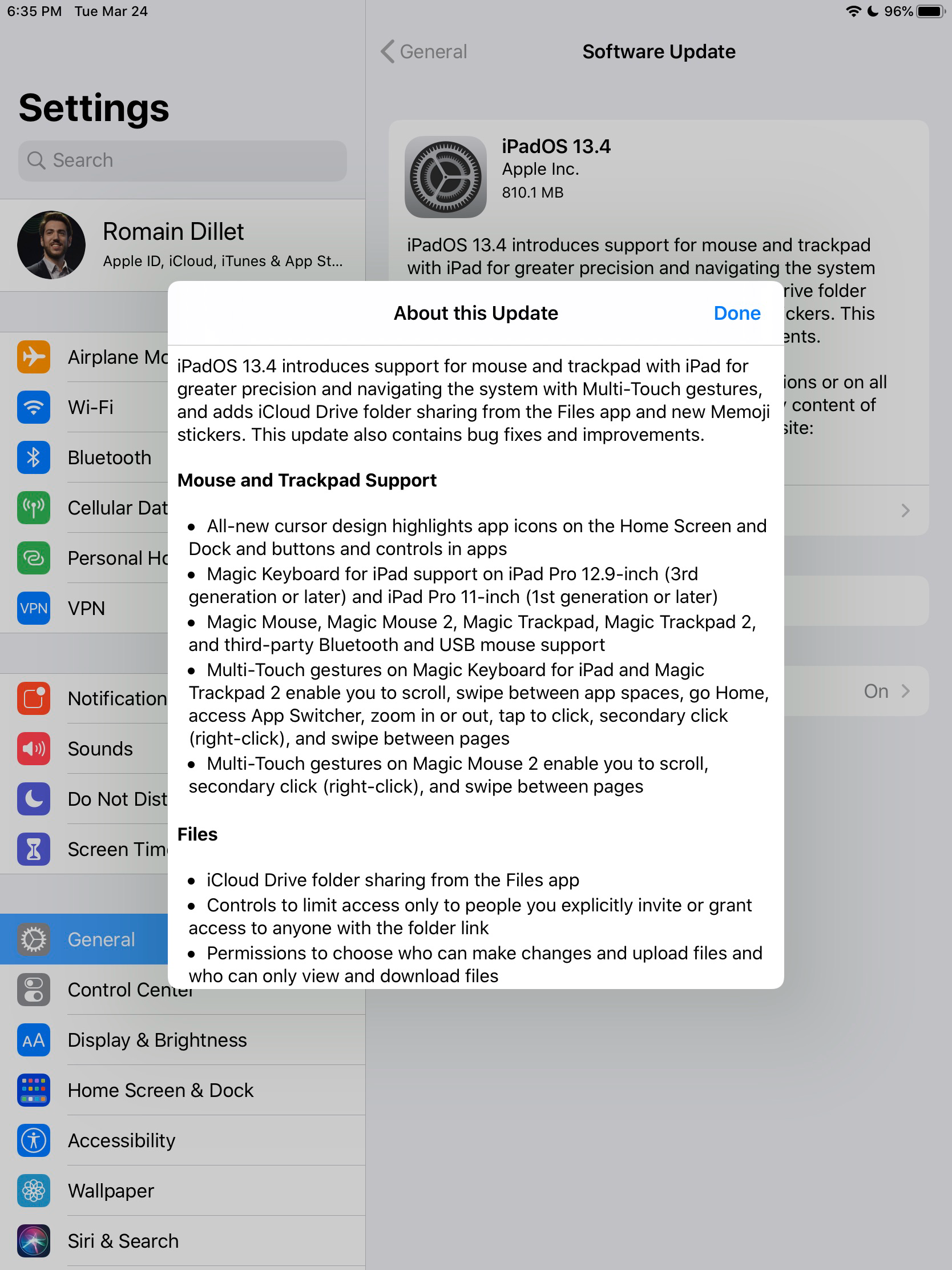
Powered by WPeMatico
Snapchat’s location-sharing app acquisition Zenly has gamified shelter-in-place during the COVID-19 outbreak. Today the app launched its Stay At Home challenge that shows a leaderboard of which friends have spent the most percentage of the last three days in their homes. Users can see who’s social distancing the best and share stickers of the scoreboard and coronavirus prevention tips to Snapchat, Instagram and other apps.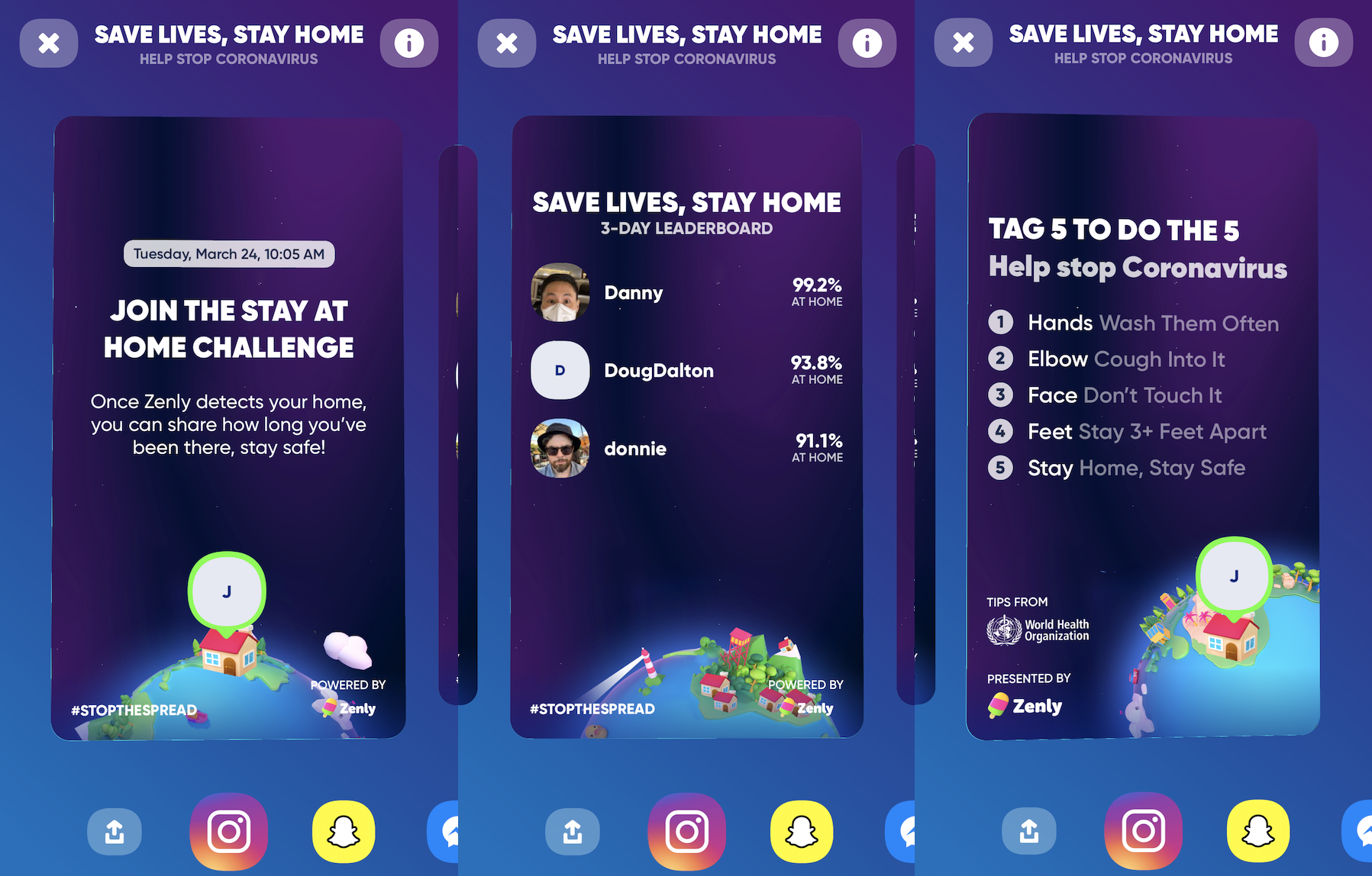
Location apps like Zenly that typically encourage users to go out and explore the world suddenly lost most of their purpose due to the widespread order for people to self-quarantine. They even might have incentivized people to disobey those orders. But by building a game around isolation, Zenly could make it cool to show off how you’re NOT grabbing coffee, visiting friends or taking a walk down Main Street.
Zenly’s CEO Antoine Martin announced the feature this morning, and credited a tweet I posted on March 15 calling for developers to build a gamified quarantine app as the inspiration. The quick work and rapid deployment was spearheaded by Danny Trinh, the renowned designer of Path who joined the company last year. TechCrunch broke the news back in June 2018 that Snapchat had acquired Zenly for $213 million plus retention bonuses.
@thek3vinkim @TurnerNovak @GillesPoupardin @LucasLambertini @nicolasfallourd for staying home!
And thanks @JoshConstine for the idea leading to this feature! pic.twitter.com/CEwrJiCFHd
— Antoine Martin (@an21m) March 24, 2020
Beyond Zenly’s version of “Pokemon No Go,” the app is also offering tips for containing coronavirus and a link to World Health Organization info. You can also attach a surgical mask to your profile pic to let your friends know you’re taking social distancing seriously.
What could really make a difference in convincing people to do their part to fight this worldwide pandemic, though, is Zenly’s coronavirus lens for its map that it released last week. It lets you look around the world and see the number of confirmed cases and recoveries in each country or state. Zenly updates the data three times per day based on the The John Hopkins Center for Systems Science and Engineering. The map also overlays info from the WHO, the Netherlands’ BNO News, China’s DXY and this crowdsourced GitHub.
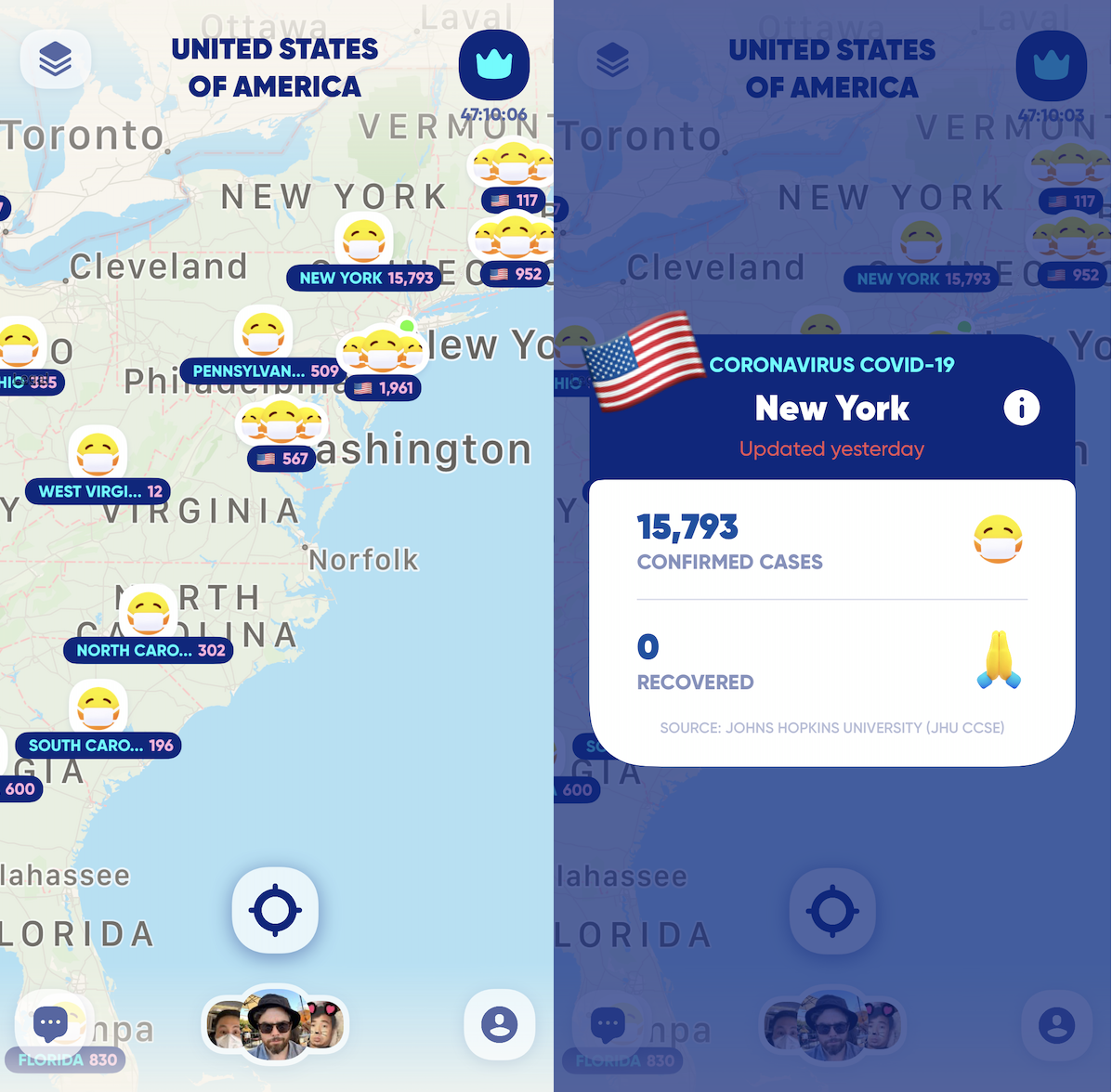
We’ve asked if there are any plans to launch similar features on Snap Map, which was inspired by Zenly. To date, Snapchat has mostly allowed its acquisition to operate independently from its existing headquarters in Paris.
“During these tough times, millions of people are turning to Zenly as a source of information and connection, so that they can feel close to friends and family even when social distancing is keeping them apart,” says Martin. “While spending too much time at home could be perceived as uncool, we wanted to flip the narrative to make it something that our community would be proud of and do our part in stopping the spread.” Foursquare founder Dennis Crowley told me his company was looking for a way to build its own quarantine gamification, and now has complimented Zenly on its execution, calling it “clever and awesome and beautiful.”
Knowing what’s happening around the globe might reinforce the gravity of our situation and that people can’t just go about their normal routine. We all have to battle this together, even if we’re stuck apart. Thanks to Zenly, social distancing just got a lot more social.
Powered by WPeMatico
Ranker, an online publisher that turns crowdsourced lists and fan rankings into a data business, is now turning its attention to the world of streaming services. The company this week launched a new app, Watchworthy, that helps you find something new to watch across TV networks and more than 200 streaming services like Netflix, Hulu, Prime Video, Apple TV+ and many more.
Ranker, as you may already know, is the website that always pops up in search results when you’re looking for some sort of “best of” round-up — whether that’s in entertainment, music, sports, culture, history or across other topics. On the site, online visitors can vote on their favorites in categories as broad as the “best hip-hop artists” or as niche as the “best coconut oil brands.”
Ranker’s TV lists are among its more popular categories and one that makes the most sense for turning into an app. And right now, everyone is looking for something new to watch as we’re stuck indoors due to the COVID-19 health crisis.
While there are already a number of apps promising to offer TV recommendations — like Reelgood, TV Time, Yidio and JustWatch, for example — Watchworthy’s advantage is Ranker’s data powering its recommendations. Its machine learning platform applies first-party correlation data it has amassed over a decade from one billion votes on Ranker.com. As the company explains, this makes its data more “statistically relevant.”
For example, its data indicates that “Better Call Saul” fans tend to like other gritty, dark dramas like “House of Cards,” “Ray Donovan” and “True Detective,” but also more cerebral comedies like “Nathan for You” and “High Maintenance.”

To figure out what sort of TV programs interest you, Watchworthy at first launch jumps you into a rating experience to provide it with your data. In 60 seconds, you fly through a ratings feature that uses a Tinder-like interface, where a right swipe is a “like” and a left swipe is a “dislike” (and up is “not sure”). After you thumbs up and down a selection of shows, you can begin to browse your recommendations.
In my test, this initial set of recommendations was already above average compared with some of the other apps I’ve tried. Your mileage may vary, of course, as it’s a highly personalized experience. Watchworthy may not have offered dozens of precise matches to my tastes at first, but it did remind me of several shows I had seen in passing and thought at some point I might like to try, as well as a few new discoveries.
Its suggestions are ranked by a “worthy” score that indicates the likelihood that the show is worthy of your time. You can also filter the list of recommendations by service, genre, run time and MPAA ratings.
The app got a little better after spending a little more time to like and dislike more shows and to personalize it as to which streaming services I was using. This allowed me to integrate recommendations from more sources — like HBO, Apple TV+, Disney+, Showtime and others.
However, I did get to the point where liking and disliking didn’t refine my recommendations further, so there is a limit to what Watchworthy can do. I also found the app to be a little lacking on the reality and nonfiction side of things. It tended to push recommendations of scripted shows, despite my having “liked” shows such as “The Great British Bake Off,” “Windy City Rehab” and “Queer Eye,” among others.
As you find shows you like in the app’s recommendations, you can add them to the universal watchlist in the app for easy access.
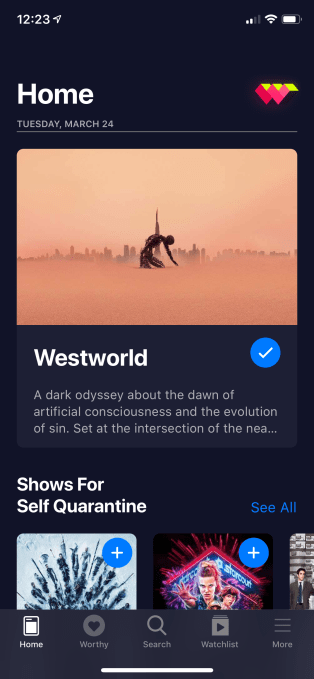
You can also create an account to save your data. Watchworthy at launch supports Apple’s private sign-in option, as well as Google, Facebook and email.
The homepage of the app also integrates Ranker’s existing TV lists. The website has more than 50,000 of these, but the app isn’t an endless scroll. Instead, it updates the home page with relevant, timely content. For example, today’s lists include “Shows For Self Quarantine,” “Shows To Distract You,” “Funniest Shows On Netflix,” “Best Family Shows On Amazon Prime” and other round-ups.
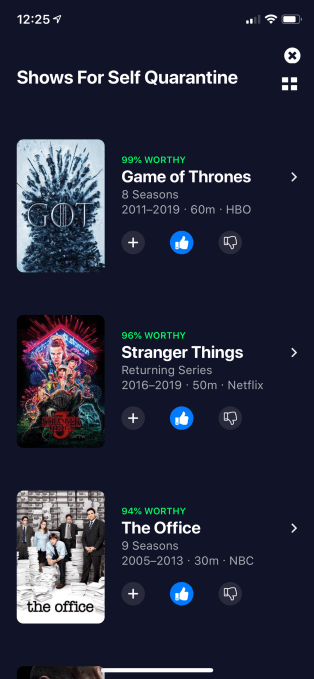
The new app serves not only as a discovery tool for TV viewers, cord-cutters and binge-watchers, but also as fuel for Ranker’s data collection business. Ranker licenses its data and insights to third-parties, like marketers, advertisers, researchers, developers and service providers. However, its data isn’t focused on demographics so much as it is on “psychographics” — meaning, your tastes. Ranker isn’t asking you for private information, only what you like.
In a way, Watchworthy serves as a demo app of what can be done with Ranker’s psychographic insights, in this case, for TV viewers. But the same sort of system could be built for other categories, like music, cooking, film, travel and more.
The company says this year it will also make its Watchworthy app available to connected devices, like Roku, Apple TV and Amazon Fire TV. It also plans to add movie recommendations and shared watchlists.
Watchworthy is a free download on iOS with Android to come. On any mobile device, it works from watchworthy.app.
Powered by WPeMatico
Now you can scroll Instagram together with friends, turning a typically isolating, passive experience into something more social and active. Today Instagram launched Co-Watching, which lets friends on a video chat or group video chat browse through feed posts one user has Liked or Saved, or that Instagram recommends.
Co-Watching could let people ooh, ahh, joke and talk about Instagram’s content instead of just consuming it solo and maybe posting it to a chat thread so friends can do the same. That could lead to long usage sessions, incentivize users to collect a great depository of Saved posts to share and spur more video calls that drag people into the app. TechCrunch first reported Instagram was testing Co-Watching a year ago, so we’ll see if it managed to work out the technical and privacy questions of operating the feature.
 The launch comes alongside other COVID-19 responses from Instagram that include:
The launch comes alongside other COVID-19 responses from Instagram that include:
These updates build on Instagram’s efforts from two weeks ago, which included putting COVID-19 prevention tips atop the feed, listing official health organizations atop search results and demoting the reach of coronavirus-related content rated false by fact checkers.
But Co-Watching will remain a powerful feature long after the quarantines and social distancing end. The ability to co-view content while browsing social networks has already made screensharing app Squad popular. When Squad launched in January 2019, I suggested that, “With Facebook and Snap already sniffing around Squad, it’s quite possible they’ll try to copy it.” Facebook tested a Watch Together feature for viewing Facebook Watch videos inside Messenger back in April. And now here we are with Instagram.
The question is whether Squad’s first-mover advantage and option to screenshare from any app will let it hold its own, or if Instagram Co-Watching will just popularize the concept and send users searching for more flexible options like Squad. “Everyone knows that the content flooding our feeds is a filtered version of reality,” Squad CEO Esther Crawford told me. “The real and interesting stuff goes down in DMs because people are more authentic when they’re 1:1 or in small group conversations.”
Squad, which lets you screenshare anything, including websites and your camera roll, won’t be fully steamrolled. When asked if Instagram would build a full-fledged screensharing feature, Instagram CEO Adam Mosseri said they’re “Not currently working on it . . . screensharing is not at the top of the list for us at Instagram.”
 With Co-Watching, Instagram users can spill the tea and gossip about posts live and unfiltered over video chat. When people launch a video chat from the Direct inbox or a chat thread, they’ll see a “Posts” button that launches Co-Watching. They’ll be able to pick from their Liked, Saved or Explore feeds and then reveal it to the video chat, with everyone’s windows lined up beneath the post.
With Co-Watching, Instagram users can spill the tea and gossip about posts live and unfiltered over video chat. When people launch a video chat from the Direct inbox or a chat thread, they’ll see a “Posts” button that launches Co-Watching. They’ll be able to pick from their Liked, Saved or Explore feeds and then reveal it to the video chat, with everyone’s windows lined up beneath the post.
Up to six people can Co-Watch at once on Instagram, consuming feed photos and videos but not IGTV posts. You can share public posts, or private ones that everyone in the chat are allowed to see. If one participant is blocked from viewing a post, it’s ineligible for Co-Watching.
Co-Watching could finally provide an answer to Instagram’s Time Well Spent problem. Research shows how the real danger in social network overuse is passive content consumption, like endless solo feed scrolling. It can inspire envy, poor self-esteem and leave users deflated, especially if the highlights of everyone else’s lives look more interesting than their own day-to-day reality. But active sharing, commenting and messaging can have a positive effect on well-being, making people feel like they have a stronger support network.
With Co-Watching, Instagram has found a way to turn the one-player experience into a multi-player game. Especially now with everyone stuck at home and unable to crowd around one person’s phone to gab about what they see, there’s a great need for this new feature. One concern is that it could be used for bullying, with people all making fun of someone’s posts.
But in general, the idea of sifting through cute animal photos, dance tutorials or epic art could take the focus off the individuals in a video chat. Not having one’s face as the center of attention could make video chat less performative and exhausting. Instead, Co-Watching could let us do apart what we love to do together: just hang out.
Powered by WPeMatico
European fintech startup Revolut is launching its app and service in the U.S. Starting today, anybody can sign up and get a Revolut debit card. In the U.S., Revolut has partnered with Metropolitan Commercial Bank for the banking infrastructure — deposits are FDIC insured up to $250,000.
In just a few years, Revolut has managed to attract over 10 million customers by building a financial hub that lets you spend, send, receive and manage money from a single app. The company recently raised a $500 million funding round, valuing the company at $5.5 billion.
But the U.S. has been watching from the sidelines. Tens of thousands of customers have signed up to the waiting list and they’ll now be able to access all of Revolut’s core features.
Like competing challenger banks, such as Chime and N26, Revolut lets you open an account from your phone. After downloading the app, you enter personal details and send a few official documents to comply with know-your-customer regulation.
After that, you get U.S. account details and you can instantly top up your account with a bank transfer or a card transfer. A few days later, you also receive a physical debit card. You can also generate a virtual debit card from the app.
Revolut lets you control your debit card from the app directly. You can receive notifications every time you make a transaction. You can freeze and unfreeze your card, set some limits and restrict some feature, such as online payments or ATM withdrawals.
One of Revolut’s key features is that you can convert from one currency to another based on interbank rate with a low fee — sometimes without any markup for popular currencies and small transactions (more details on foreign exchange fees here). You can hold foreign currencies in your Revolut account or send money to another Revolut user or a bank account in another country.
In the U.S., Revolut offers the ability to receive your salary two days in advance if you share your Revolut banking details with your employer.
Revolut offers a ton of additional features in Europe, but the company is starting with this basic feature set in the U.S. You can expect more features in the future, such as the ability to purchase cryptocurrencies and invest on the stock market.
In Europe, Revolut also offers insurance products through premium monthly subscriptions, mobile phone insurance, savings accounts, credit, rewards and more. Many of those features require partnerships with third-party companies. But it gives you an idea of Revolut’s roadmap in the U.S.

Powered by WPeMatico
The flood of status symbol content into Instagram Stories has run dry. No one is going out and doing anything cool right now, and if they are, they should be shamed for it. Beyond sharing video chat happy hour screenshots and quarantine dinner concoctions, our piece-by-piece biographies have ground to a halt. Oddly, what remains feels more social than social networks have in a long time.
With no source material, we’re doing it live. Coronavirus has absolved our desire to share the recent past. The drab days stuck inside blur into each other. The near future is so uncertain that there’s little impetus to make plans. Why schedule an event or get excited for a trip just to get your heartbroken if shelter-in-place orders are extended? We’re left firmly fixed in the present.

A house-arrest Houseparty, via StoicLeys
What is social media when there’s nothing to brag about? Many of us are discovering it’s a lot more fun. We had turned social media into a sport but spent the whole time staring at the scoreboard rather than embracing the joy of play.
But thankfully, there are no Like counts on Zoom .
Nothing permanent remains. That’s freed us from the external validation that too often rules our decision making. It’s stopped being about how this looks and started being about how this feels. Does it put me at peace, make me laugh, or abate the loneliness? Then do it. There’s no more FOMO because there’s nothing to miss by staying home to read, take a bath, or play board games. You do you.
Being social animals, what feels most natural is to connect. Not asynchronously through feeds of what we just did. But by coexisting concurrently. Professional enterprise technology for agenda-driven video calls has been subverted for meandering, motive-less togetherness. We’re doing what many of us spent our childhoods doing in basements and parking lots: just hanging out.
For evidence, just look at group video chat app Houseparty, where teens aimlessly chill with everyone’s face on screen at once. In Italy, which has tragically been on lock down since COVID-19’s rapid spread in the country, Houseparty wasn’t even in the top 1500 apps a month ago. Today it’s the #1 social app, and the #2 app overall second only to Zoom which is topping the charts in tons of countries.
Houseparty topped all the charts on Monday, when Sensor Tower tells TechCrunch the app’s download rate was 323X higher than its average in February. As of yesterday it was #1 in Portugal (up 371X) and Spain (up 592X), as well as Peru, Argentina, Chile, Austria, Belgium, and the U.K. I despite being absent from the chart a week earlier. Apptopia tells me Houseparty saw 25 downloads in Spain on March 1st and 40,000 yesterday.
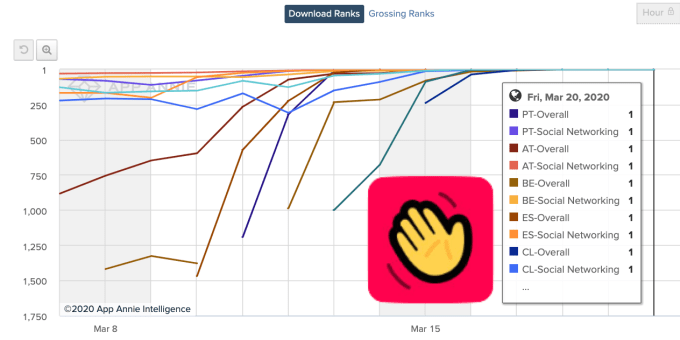
Houseparty rockets to #1 in many countries
A year ago Houseparty was nearly dead, languishing at #245 on the US charts before being acquired by Fortnite-maker Epic in June. Our sudden need for unmediated connection has brought Houseparty roaring back to life, even if Epic has neglected to update it since July.
“Houseparty was designed to connect people in the most human way possible when they are physically apart” the startup’s co-founder Ben Rubin tells me. “This is a time of isolation and uncertainty for us all. I’m grateful that we created a product that gives a sense of human connection to millions people during this critical moment.”
Around the world, apps for direct connection are spiking. Google Hangouts rules in Sweden. Discord for chat while gaming is #1 in France. Slack clone Microsoft Teams is king in the Netherlands. After binging through Netflix, all that’s left to entertain us is each other.
If we’re all stuck at home, it doesn’t matter where that home is. We’ve been released from the confines of which friends are within a 20 minute drive or hour-long train. Just like students are saying they all go to Zoom University since every school’s classes moved online, we all now live in Zoom Town. All commutes have been reduced to how long it takes to generate an invite URL.
Nestled in San Francisco, even pals across the Bay in Berkeley felt far away before. But this week I had hour-long video calls with my favorite people who typically feel out of reach in Chicago and New York. I spent time with babies I hadn’t met in person. And I kept in closer touch with my parents on the other coast, which is more vital and urgent than ever before.
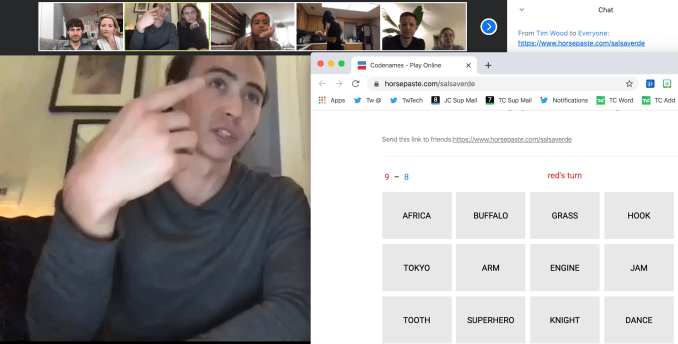
Playing board game Codenames over Zoom with friends in New York and North Carolina
Typically, our time is occupied by acquaintances of circumstance. The co-workers who share our office. The friends who happen to live in the neighborhood. But now we’re each building a virtual family completely of our choosing. The calculus has shifted from who is convenient or who invites us to the most exciting place, to who makes us feel most human.
 Even celebrities are getting into it. Rather than pristine portraits and flashy music videos, they’re appearing raw, with crappy lighting, on Facebook and Instagram Live. John Legend played piano for 100,000 people while his wife Chrissy Teigen sat on screen in a towel looking salty like she’s heard “All Of Me” far too many times. That’s more authentic than anything you’ll get on TV.
Even celebrities are getting into it. Rather than pristine portraits and flashy music videos, they’re appearing raw, with crappy lighting, on Facebook and Instagram Live. John Legend played piano for 100,000 people while his wife Chrissy Teigen sat on screen in a towel looking salty like she’s heard “All Of Me” far too many times. That’s more authentic than anything you’ll get on TV.
And without the traditional norms of who we are and aren’t supposed to call, there’s an opportunity to contact those we cared about in a different moment of our lives. The old college roommate, the high school buddy, the mentor who gave you you’re shot. If we have the emotional capacity in these trying times, there’s good to be done. Who do you know who’s single, lives alone, or resides in a city without a dense support network?
Reforging those connections not only surfaces prized memories we may have forgotten, but could help keep someone sane. For those who relied on work and play for social interaction, shelter-in-place is essentially solitary confinement. There’s a looming mental health crisis if we don’t check in on the isolated.
It can be hard to muster the energy to seize these connections, though. We’re all drenched in angst about the health impacts of the virus and financial impacts of the response. I certainly spent a few mornings sleeping in just to make the days feel shorter. When all small talk leads to rehashing our fears, sometimes you don’t have anything to say.
Luckily we don’t have to say anything to communicate. We can share memes instead.

My father-in-law sent me this. That’s when you know memes have become the universal language
The internet’s response to COVID-19 has been an international outpour of gallow’s humor. From group chats to Instagram joke accounts to Reddit threads to Facebook groups like quarter-million member “Zoom Memes For Quaranteens”, we’re joining up to weather the crisis.
A nervous laugh is better than no laugh at all. Memes allow us to convert our creeping dread and stir craziness into something borderline productive. We can assume an anonymous voice, resharing what some unspecified other made without the vulnerability of self-attribution. We can dive into the creation of memes ourselves, killing time under house arrest in hopes of generating smiles for our generation. And with the feeds and Stories emptied, consuming memes offers a new medium of solidarity. We’re all in this hellscape together so we may as well make fun of it.
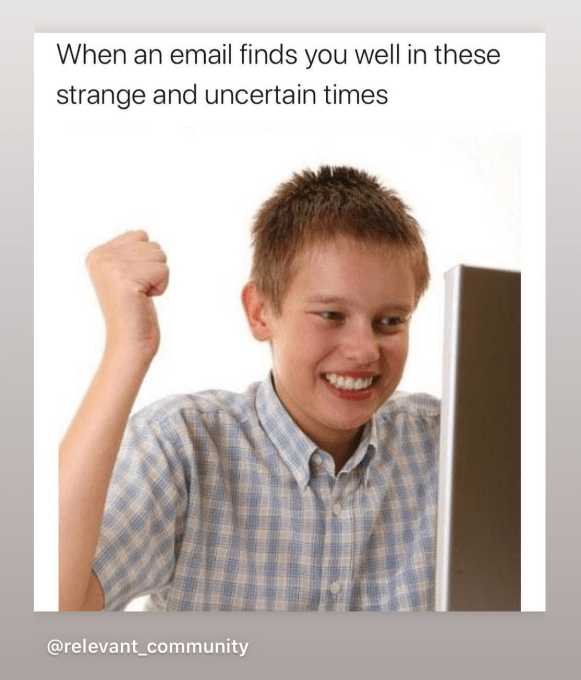
The web’s mental immune system has kicked into gear amidst the outbreak. Rather than wallowing in captivity, we’ve developed digital antibodies that are evolving to fight the solitude. We’re spicing up video chats with board games like Codenames. One-off livestreams have turned into wholly online music festivals to bring the sounds of New Orleans or Berlin to the world. Trolls and pranksters are finding ways to get their lulz too, Zoombombing webinars. And after a half-decade of techlash, our industry’s leaders are launching peer-to-peer social safety nets and ways to help small businesses survive until we can be patrons in person again.
Rather than scrounging for experiences to share, we’re inventing them from scratch with the only thing we’re left with us in quarantine: ourselves. When the infection waves pass, I hope this swell of creativity and in-the-moment togetherness stays strong. The best part of the internet isn’t showing off, it’s showing up.
Powered by WPeMatico